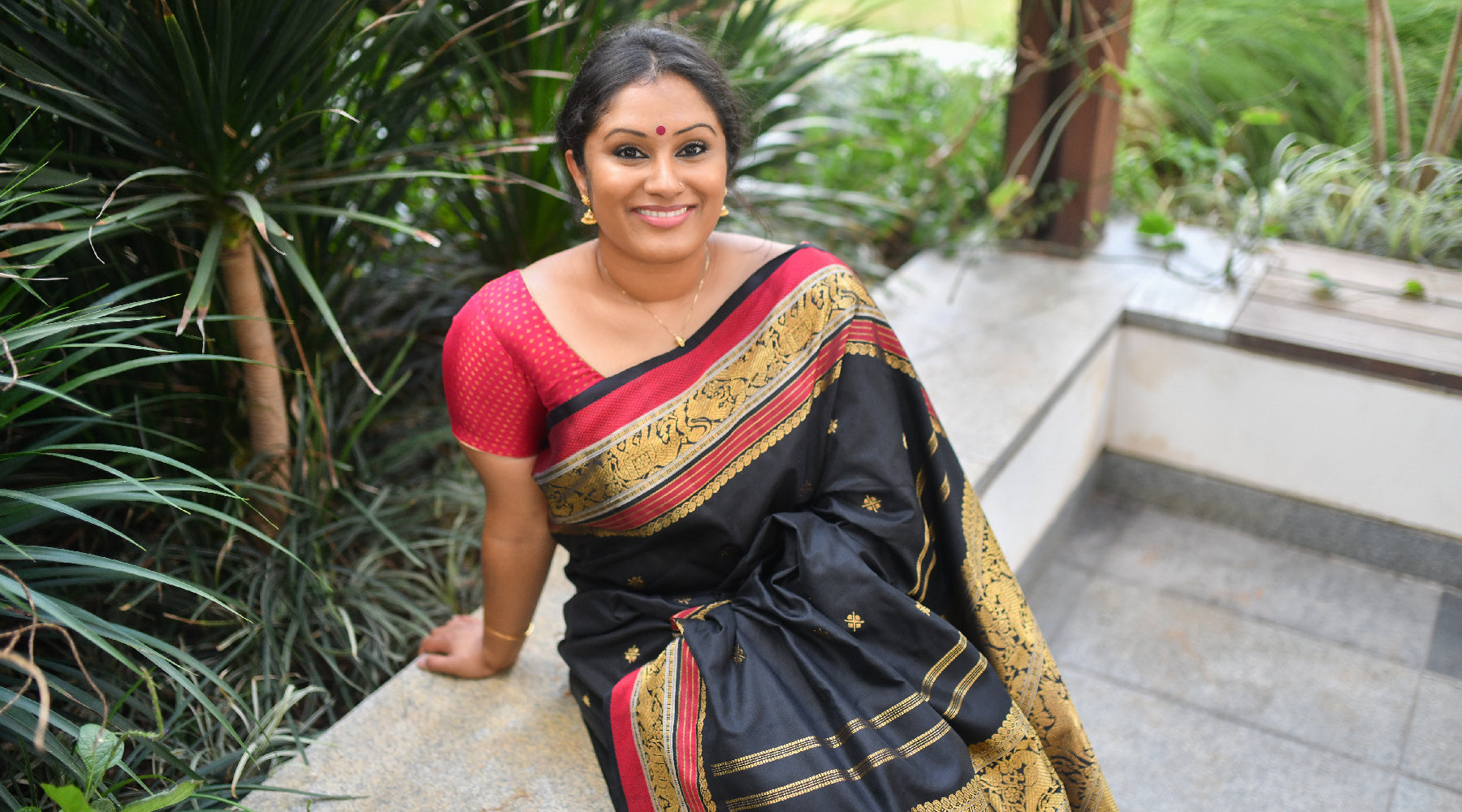KANAKAVALLI VIGNETTES : Sai Ravi - Inheritance

Kanakavalli’s September Vignette, Sai Ravi traces her love for the kanjivaram to her mother and grandmother, whose elegance she grew up admiring. An investment banker living in Sydney and a strong role model for young women in the workforce, Sai reflects on the fluid work-life balance she has discovered, managing a demanding role at the office, time with her family and veena lessons with her mother. In conversation with Aneesha Bangera of The Kanakavalli Journal, she opens up about leaving Sri Lanka as a teenager and finding a home in Australia. Despite staying intimately connected with her Tamil roots, Sai has embraced the melting pot of cultures that Sydney offers, celebrating the best of the many traditions she discovered there. Still, no matter the occasion—corporate event or black-tie dinner—she will always be seen draped in a beautiful and classic sari. In the midst of a busy work and travel schedule, Sai takes a moment to curate a selection of kanjivarams that epitomise her vibrant personality. Excerpts of the conversation below…
Inheritance
Home and away
My family is originally from Sri Lanka, but we migrated to Australia when I was 16 years old. Before that we lived with our extended family in Jaffna in the north, and I remember my childhood being very idyllic. Despite the civil war in the country, we were quite sheltered from it all until I was in my teens, when we began to feel the tensions. When we finally left, unfortunately, it was not a very pleasant time—we didn’t feel safe in our homes and our parents worried for the future.
For me, home is a place where you feel safe, loved, and where you experience the kindness of family, friends and neighbours. Australia truly embraced us and welcomed us with open arms. Being in this country has offered us incredible opportunities as well as a feeling of security, and we all consider it home now.

Sai and her mother, both wearing Kanakavalli saris
I come from quite a traditional Tamil family, where culture and roots have always been very important. My mother is a veena player and teacher and is a graduate of the Government Music College Chennai. Growing up, we were surrounded with singers and musicians. Thus, we all share a very close relationship with Chennai and its culture. I truly enjoy staying connected to my roots through my relationship with my extended family, the arts and the food. At the same time, I think Australia is an amazing place and I have tried to embrace everything it has to offer. The indigenous Australians have a beautiful culture, and I think it has a lot of common elements to our own—the idea of a close relationship with the land, respect for elders, the worship of nature and reverence for women. Australia is also a very multicultural society. The neighbourhood I live in in Sydney is truly cosmopolitan, with large Asian, Greek and Italian populations. I think of it as a cultural melting pot, so while I am very connected to my own roots, I strongly believe that it’s important to imbibe and celebrate the best of everything.
Mothers & Daughters
My mother is a veena player and used to teach students at home. So, the veena was always very much a part of my childhood, and I started formal lessons at the age of seven. I started learning from my mother’s teacher, and began to learn from my mother after moving to Australia. She still teaches and performs, and I have accompanied her as a second veena at concerts. At the moment life is very, very busy and I don’t practice as much as I should. I look forward to lessons, and even though my mother is a strict disciplinarian and chides me for not practicing enough, I enjoy and cherish this time together. It’s a very special way of bonding with each other. My children play as well, so I feel like the veena is something that we are passing down through the generations of my family. The other thing I inherited from my mother is a love for silk saris. She still buys all my saris—I have never bought my own!

Sai performing with her mother at a Veena concert in Sydney in 1990
I’m fortunate to share a very close relationship with my mother even today. She lives just five minutes away from me, and she has been a big part of my children’s lives, helping out when they were young and continuing to be an involved grandparent. I’m the eldest daughter and both my siblings live outside Australia, so I feel lucky to be so close to her.
Work, life & striking a balance
I work for an American Investment Bank, running regulatory solutions for APAC. Work is very busy, but I think I am able to find a semblance of a work-life balance because of the incredible support system I have. With technology, there is a lot more opportunity now to manage time better, and work from home when required. Having said that, I try not to compartmentalise too much between work and home. I’m quite relaxed in that way and have found a fluid way of managing my time. I have always had really good teams working for me, as well as great mentors and the office has a great culture of support. When the children were young, I could drop them to school and then go in to work, managing meetings appropriately so I could take time off to go for concerts or events when I needed to.

Above (left to right): Sai and her husband at a colleague's wedding in Sydney; At a family friend's wedding - Sai is wearing a Kanakavalli kanjivaram and jewellery by Ahalya
My husband works very long hours as well, and we are so fortunate to have the help of my parents as well as my in-laws who live in New Zealand but visit often. They say it takes a village to raise a child, and I have utilised my village!
As a woman juggling multiple demanding roles every day, I don’t think you can be too rigid in your expectations. I believe that strong communication with your family really helps. Whenever I’ve taken on a new role or project, I’ve always first sat down with my entire family, including the children, to talk about what that role will involve and to ensure they are okay with it.
I also believe that there are some advantages to being a working mother, as children learn to do things on their own quite early. My own children have developed a deep sense of independence, since they have never been spoon-fed. In addition, I think that young girls need strong women role models, and as a working mother I have had the opportunity to be that for my daughter as well as for younger women in the workforce. There was a time when there were fewer women choosing careers in investment banking in Australia, and I was often asked to mentor young women.

With her parents, children, sister and family at her niece's wedding in New Zealand a few years ago - Sai is wearing one of her favourite Kanakavalli kanjivarams paired with jewellery by Ahalya
In addition to all this, it definitely helps to have an understanding partner and open communication with the family. We need parents to support young couples when they both choose to work, and not have rigid expectations of how they should lead their lives.
Finding beauty
For me, beauty is inside and out. When it is physical beauty it is quite subjective; as they say, beauty is in the eye of the beholder. But what has always attracted me, more than physical appearance, is when I see something radiating from within.
I think the sari is connected to my definition of beauty—it makes you glow from within. The sari suits everyone and brings out the best in every woman. For me, nothing beats a classic kanjivaram, no matter where I’m going. It is so traditional and yet so incredibly versatile. I wear saris everywhere, even to corporate functions. Everyone I work with knows that I don’t do ball gowns. If the dress code is black-tie or semi-formal, I’ll choose a kanjivaram!
The kanjivaram reminds me of all the good things in life. My maternal grandmother always wore a kanjivaram, even at home. She was a beautiful woman who radiated goodness from within, and was always very elegant. I think my love of saris began with watching her draped in beautiful saris when I was a little child.

Above (left to right): Sai as a baby with her grandmother who had an extensive collection of kanjivarams; Sai at age 4 in Sri Lanka
On her Vignettes sari
My mother has the uncanny ability to pick saris that perfectly suit each of her daughters. And I am happy to outsource all my sari shopping to her because I trust her taste. I end up with a lot of rich, bright colours, which I don’t mind because I think they reflect my personality. She picked this sari for me some time ago, and I loved it immediately. I didn’t have a chance to wear it for almost a year, until my cousin’s wedding in Malaysia. It was a special occasion because we met my father’s entire extended family, and this is such a happy sari that is now associated with wonderful memories.
My mother loves Kanakavalli and has a very intimate relationship with some of the staff who know what she likes and help her with her shopping. She browses online, and visits the store when she’s in India as well. I take every opportunity to visit Kingsley with her and also love the jewellery collection. My mother had a milestone birthday last year so I wrote to a Kanakavalli executive asking her to help me choose a kanjivaram for my mother. It was such a lovely experience interacting with her—she sent me three options and I picked one that my mother just loved.

Sai is wearing an elegant Kanakavalli kanjivaram sari in a dual shade of pink dotted with paisley motifs in gold zari. The border has geometric and paisley patterns, while geometric and temple motifs adorn the pallu, all in fine gold zari.
- Sai Ravi, in conversation with Aneesha Bangera, photography by Raghuram Vedant
View Sai's guest curation here.



